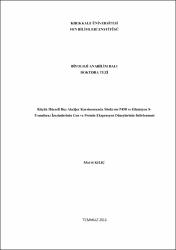Küçük hücreli dışı akciğer karsinomunda sitokrom P450 ve glutatyon s-transferaz izozimlerinin gen ve protein ekspresyon düzeylerinin belirlenmesi
Abstract
Akciğer kanserinin, polisiklik aromatik hidrokarbonlar ve nitrozamin gibi sigara dumanında bulunan karsinojenlere maruziyet sonucu oluştuğu bilinmektedir. Ksenobiyotiklerin etkilerinin, enzim ya da çeşitli moleküller yardımıyla zararsız hale getirilerek vücuttan atılması, detoksifikasyon mekanizmaları ile sağlanır. Detoksifikasyon mekanizmasında, Sitokrom P450 (CYP) izozimlerinin katalizlediği I. Faz reaksiyonlarında, lipofilik ksenobiyotikler genelde daha polar türevlerine dönüştürülürler ve II. Faz reaksiyonları ile konjugasyona uğrayıp vücuttan atılırlar. Ksenobiyotiklerin özellikle karsinojenik etkilerinden korunmada, beş farklı II. Faz reaksiyonlarından biri olan glutatyon ile konjugasyonda, glutatyon-S-transferaz (GST) izozimleri önemli rol oynar. Bu çalışmada, Küçük Hücreli Dışı Akciğer Karsinomu (KHDAK)?da CYP ve GST izozimlerinin mRNA ve protein ifadelerinin incelenmesi amaçlanmıştır. Bu amaçla, Atatürk Göğüs Hastalıkları ve Göğüs Cerrahisi Eğitim ve Araştırma Hastanesi Patoloji Bölümü?nden alınan KHDAK?lı 39 hastanın (3 Kadın, 36 Erkek; 57,41±8,09), normal ve tümörlü parafine gömülü dokuları çalışma grubu olarak belirlendi. Tümörlü ve normal dokularda CYP1A1, CYP1B1, CYP2E1, GSTM1, GSTP1 ve GSTT1 izozimlerinin mRNA ifadeleri RT-PCR yöntemiyle, protein ifadeleri immunohistokimyasal boyama yöntemiyle belirlendi. Tümörlü ve normal dokular arasında, çalışılan genlerin mRNA ifadelerinin rölatif kantitasyon oranları incelendiğinde, CYP1A1 mRNA?sının 4 hastanın normal dokularında; CYP1B1 mRNA?sının 9 hastanın tümörlü ve 6 hastanın normal dokularında olmak üzere toplamda 15 hastada; CYP2E1 mRNA?snın 3 hastanın tümörlü ve 4 hastanın normal dokularında olmak üzere toplamda 7 hastada; GSTP1 mRNA?sının 8 hastanın tümörlü, 5 hastanın normal dokularında olmak üzere toplamda 13 hastada; GSTM1 mRNA?sının 5 hastanın tümörlü, 8 hastanın normal dokularında olmak üzere toplam 13 hastada; GSTT1 mRNA?sının 10?u tümörlü, 15?i normal dokularda olmak üzere toplamda 25 hastada ifade olduğu görüldü. İmmunohistokimyasal incelemelerde; GSTP1 ve CYP1B1 izozimlerinin tümörlü ve normal dokularda aşırı ifade olduğu görülürken, CYP1A1 izoziminin akciğer adenokarsinomlu dokularda, normal dokulara oranla; CYP2E1 ve GSTM1 izozimilerinin, KHDAK?lı hastaların tümörlü dokularında normal dokularına oranla daha fazla ifade edildiği istatistiksel olarak anlamlı bulundu (p<0,05). Hastaların klinik bilgileri ile protein ifadeleri arasındaki ilişki incelendiğinde, tümör evresi ile GSTP1 izoziminin protein ifadesi arasında pozitif yönde bir ilişki olduğu görüldü (r=0,30, p<0,05). Sonuç olarak, Hastaların tümörlü ve normal dokuları arasında görülen CYP ve GST izozimlerinin, gen ve protein ifadelerindeki farklılıklar, KHDAK?nun oluşumunda ve kemoterapötik açıdan ilaç dirençlilik mekanizmalarında önemli rollerinin olabileceğini göstermektedir. Lung cancer is known to occur mainly as a result of exposure to carcinogens such as polycyclic aromatic hydrocarbons and nitrosamine, which are present in cigarette smoke. The interference with the harmful effects of xenobiotics by removal of them from the body with enzymes or the help of various molecules in a harmless way is provided with detoxification mechanisms. In Phase I reaction catalyzed by Cytochrome P450 (CYP) isoenzymes in the detoxification metabolism, lipophilic xenobiotics are generally converted to more polar derivatives, and these polar derivatives are eliminated from the body by Phase II conjugation reactions. Particularly, in the prevention of carcinogenic effects of xenobiotic, glutathione S-transferases (GSTs) in conjugation with glutathione, which is one of the five different Phase II reactions, plays an important role. This study aimed to evaluate mRNA and protein expressions of CYP and GST isoenzymes in non small cell lung carcinoma (NSCLC). For this purpose, paraffin-embedded normal and cancerous tissues from 39 patients (3 female, 36 male; 57.41±8.09) with NSCLC were used as the study materials were obtained from the Atatürk Chest Diseases and Chest Surgery Education and Research Hospital Department of Pathology. mRNA and protein expressions of CYP1A1, CYP1B1, CYP2E1, GSTM1, GSTT1, and GSTP1 isoenzymes were detected RT-PCR and immunohistochemical staining methods, respectively. In examination of mRNA expression relative quantification ratios of the gene studied, the followings were detected: CYP1A1 mRNA in normal tissues of 4 patients, CYP1B1 mRNA in tumor tissues of 9 patients and normal tissues of 6 patients with a total of 15 patients, CYP2E1 mRNA in tumor tissues of 3 patients and normal tissues of 4 patients with a total 7 patients; GSTP1 mRNA in tumor tissues of 8 patients and normal tissues of 5 patients with a total of 13 patients, GSTM1 mRNA in tumor tissues of 5 patients and normal tissues of 8 patients with a total of 15 patients, and GSTT1 mRNA in tumor tissues of 10 patients and normal tissues of 15 patients with a total of 25 patients out of 39 NSCLC patients. In immunohistochemical examinations, CYP1A1 isoenzyme expression was significantly higher in lung adenocarcinoma tissues than normal tissues, CYP2E1 and GSTM1 isoenzymes expressions were significantly higher in tumor tissues than normal tissues in NSCLC patients (p<0,05) whereas GSTP1 and CYP1B1 isoenzymes overexpressed in both tumors and normal tissues. In examination of patients in regard to relationship with their clinical data and protein expression profile, a low positive correlation was observed between GSTP1 protein expression and the tumor stage (r=0,30, p<0,05). As a conclusion, the differences in gene and protein expressions of CYP and GST isoenzymes between tumor and normal tissues of the patients might show their possible roles, which may be important in pathogenesis of NSCLC and chemotherapeutic drug resistance mechanisms.
















